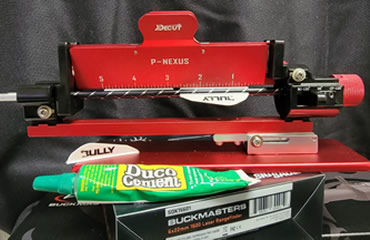Bowhunters will be heading to the woods over the next few weeks, which means a lot of last-minute practice and tuning is going on right now.
If you're like me, you have trouble aiming at different dots - there's something pleasing about a group so tight you can easily put your hand around. The down side is aiming at one dot like that means you'll ruin a lot of fletching.
If you don't fletch your own arrows, that means any shaft with even the slightest tear or nick in one of the vanes is out of commission until you can get it to a bow shop. The closest shop for me is an hour away, so that's not a great option. Plus, there are other benefits to fletching your own arrows, like being able to experiment with different vanes, selecting your favorite colors, etc.
Fletching arrows can be as simple as using the Quick Fletch style products that you place in boiling water and which shrink to the shaft to form a perfect fletch. Those products work very well, but they are a bit expensive. One of the biggest benefits of the shrink-fletch products is you don't have to worry about the vanes staying on.
Another option is to get a vane jig. There are several products to choose from in including the Arizona E-Z Fletch, Blitzenburger jig, Bohning Tower Jig and more. The Arizone E-Z Fletch and Bohning Tower jigs allow you to apply three vanes at once.
One-vane-at-a-time jigs like the Blitzenburger offer more options for customization of offset and vane angle. I started off with an Arizona E-Z Fletch but have since switched to single-vane jigs. If you're considering the Arizona E-Z Fletch, be sure to get the model made for the diameter arrow you shoot. Single-vane jigs handle a wide variety of diameters without any issues or adjustment necessary.
I'd love to tell you to use one specific glue, but some glues seem to work better with some arrows. Whether you shoot carbon or aluminum shafts affects the bonding process. Some of the more popular glues include Goat Tuff, Bohning Fletch-Tite, Duco Cement, Pine Ridge Instant Arrow Glue, AAE Max Bond and plenty more. Almost all the glues fall into one of two categories: cyanoacrylate or solvent-based.
In short, cyanoacrylate glues are faster, while solvent-based glues are more durable. Cyanoacrylate glues are vastly more popular, but I recommend solvent-based.
One thing I've noticed but haven't seen much in articles is all the glues are most effective immediately after opening the seal. It can be months or even a year between my fletching sessions, so it's probably natural the glue would lose effectiveness over that time, but it just seems like a huge waste to use glue once and then throw it away. It's up to you, but just know there is a noticeable difference.
Another tip is to use an alcohol wipe on the shaft and fletching before you apply the vanes. Removing skin oils and other residue makes a big difference in adhesion.
After you finish an arrow, let it stand for 24 hours or so, and then test the adhesion by flexing the vanes with some force. If one of more vanes snap off, clean the shaft surface and reapply with a fresh vane. Do not try to reuse the failed vane. As long as you haven't moved the nock, you can fix a single vane. Once you've shot the arrow and possibly twisted the nock for vane clearance, it's usually best to start over with a bare shaft, even if only one vane is damaged.
Finally, take your time, especially when fletching multiple arrows. I like to fletch over several days, and I keep a jig on my desk at work. I apply one vane and just let it on the jig for an hour or more. It's a slow process, but it produces better, cleaner results.
If this sounds intimidating, trust me when I say it's not. You'll make a few mistakes at first, but it's simply a matter of stripping botched vanes and trying again. It won't be long before you're making perfect fletchings (almost) every time.
Read Recent Tip of the Week:• Patience, Patience: The game isn’t over until the fat lady shoots ... or something like that.




.png)